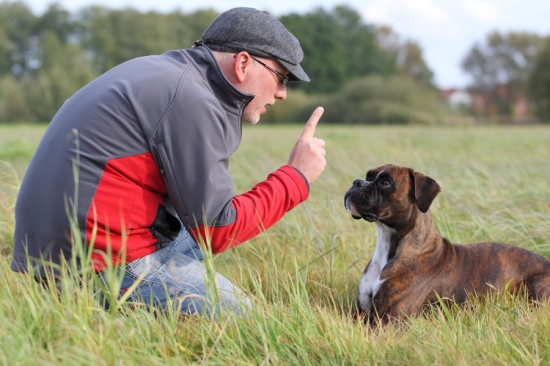Though dogs demonstrating their tricks are an impressive sight, dog obedience training is about far more than teaching a dog a repertoire of tricks and commands.
Though dogs demonstrating their tricks are an impressive sight, dog obedience training is about far more than teaching a dog a repertoire of tricks and commands. There are some dogs that can sit on command, but it doesn’t necessarily mean that they are well trained. Dog obedience training is more about the dog obeying you, his pack leader, at all times and under all circumstances, without the need for treats to motivate his cooperation.
Dog obedience training is a process of conditioning your dog to understand and internalize certain commands and to understand that doing them is good because, well, his pack leader says so. Much success in dog obedience training can be attributed to body language and the tone and inflection of voice. You need to assert the sort of calm authority that doesn’t need to prove itself. One dog professional likens it to a bouncer at a bar: You see the bouncer there, and you know his role in the situation. He probably doesn’t even have to say anything or even look at you for you to know he’s in charge because his confidence, demeanor, and carriage articulate that clearly. It’s much the same with dog obedience training. This is not to say that dogs need to be intimidated, but only that you, yourself, have the confidence and carriage to believe and communicate that you are in control. This is called pack leadership, and it is essential to your dog’s understanding of his role in your world together.
Dogs sense uncertainty and lack of confidence, and some of the same things that will trigger a response in humans will trigger a similar response in dogs. For example: When a person acts overly aggressive and pointlessly assertive with a bloated sense of authority, we tend to assume they’re masking insecurity. When a dog sees the same thing, they aren’t impressed by pack leadership skills; they see someone who’s the antithesis of a leader. And a dog without a confident pack leader is an insecure dog, which leads to a host of dog behavioral problems. Dogs need leadership. Period.
Dog obedience training is more important than many people realize. You may have to rethink any previous notions about pampering your dog if those ways run counter to good pack leadership, but you can build a healthy and mutually satisfying relationship with your dog with proper dog obedience training. Though it’s easy to make simple mistakes with posture, tone, and handling when you’re trying dog obedience training, these things that actually require little in the way of effort (but much in the way of consistency) matter a lot to the dog because it is, after all, the language that they understand. An experienced dog trainer can easily spot any errors you may be making and help you correct them so that you can provide consistent, confident pack leadership that will make your dog obedience training efforts rock solid.

 Basic Health Tips For New Dog Owners
Basic Health Tips
Basic Health Tips For New Dog Owners
Basic Health Tips
 Whats The Difference Between A Ragdoll And Ragamuffin?
Whats The Differe
Whats The Difference Between A Ragdoll And Ragamuffin?
Whats The Differe
 How To Find & Choose The Best Stud Dog
How To Find & Cho
How To Find & Choose The Best Stud Dog
How To Find & Cho
 Puppies - First Impressions Really Count
Puppies - First I
Puppies - First Impressions Really Count
Puppies - First I
 Why Training The Owner Is Just As Important As Training The Dog
Why Training The
Why Training The Owner Is Just As Important As Training The Dog
Why Training The